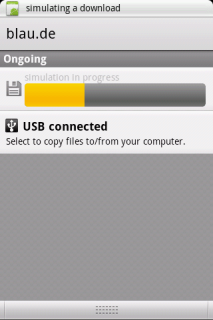 When you download from the Market you get informed about the progress in the notification area.
When you download from the Market you get informed about the progress in the notification area.
That's a really nice feature, which you may want for your own download or processing progress. I will show you the basics of generating such a Notification. All you need to do is add it to your code.
I included a screenshot. You can find the code at github.
First of all, you need your Notification object:
// configure the notification
final Notification notification = new Notification(R.drawable.icon, "simulating a download", System
.currentTimeMillis());
notification.flags = notification.flags | Notification.FLAG_ONGOING_EVENT;
